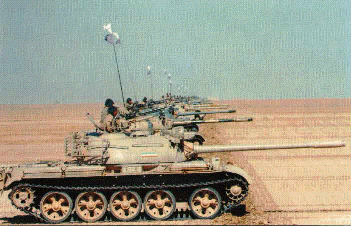

The National Liberation Army of Iran, the military arm of the Resistance, was founded by the Resistance's leader Massoud Rajavi in June 1987. The need for such an army arises from the absolute repression of the mullahs, which precludes organizing a nation wide popular uprising.
Having learned from the lesson of the shah's overthrow, the ruling clerics heighten the suppression of the people grow more enraged. Hence, the need for a force that, when the moment is right, can take on the Guards, removing the primary obstacle to a popular uprising. This is the ultimate objective of the NLA. For obvious reasons the only practical place for the NLA's bases is Iran's western border.
During the Iran-Iraq war, the formation of a genuine popular liberation army demonstrated to the Iranian people that the war was illegitimate. A multitude of the regime's army officers and soldiers defected to the NLA at the time.
In June 1988, the army liberated the town of Mehran in western Iran. In the course of the battle, many of the regime's military personnel, particularly units of the regular army, cooperated with the NLA, which seized 2 billion dollars in war booty, includ ing hundreds of tanks, field guns and armored personnel carriers as well as thousands of semi-heavy and light weapons. Later on, this cache became the main source of the army's armaments and ammunition.
In another operation ( Operation Eternal Light), in late July 1988, the liberation army penetrated 170 Km inside Iran, liberating the cities of Kerend and Islamabad, and reaching the outskirts of Kermanshah, the biggest western Iranian city. This shook the regime to its foundations , driving home the lethal threat the NLA represents. During the operation, 55,000 Guards were killed or wounded, while 1,263 combatants of the NLA were slain or captured.
In March 1991, at the end of the Persian Gulf Crisis, the mullahs attempted to exploit the regional and international situation to eliminate the NLA. With a force of seven divisions and brigades, the regime launched an offensive against the Army's garrisons. The NLA had absolutely refrained from any involvement in the domestic affairs of Iraq, and was solely focused on the main enemy of the Iranian people, namely the mullahs and the Guards. To minimize the chances of being dragged into the conflict, the a rmy had transferred its forces in the northern and southern sectors of the border to the central frontier.
The Guards, bent on annihilating the NLA, were decimated( Operation Pearl). Some 5000 were killed or wounded, and several were captured. All the while, the United Nations was kept informed of the details of the regime's aggression and atrocities.
Over the years, the NLA opened and directed its own military academy, where combatants went through extensive training. During this period, the NLA developed into a mechanized fighting force. The Army now has tank, mechanized infantry, artillery, engineer ing and communications units. The NLA also formed assault and army aviation helicopter units.
Women play a very prominent role in the NLA. One-third of its rank and file and the majority of its commanders are women, making the liberation army unique. The NLA has trained women helicopter pilots as well.
Scores of reporters from international news organizations( see reports) have visited the NLA's bases on various occasions. Commenting on the NLA's five-hour military parade in the fall of 1991, Reuters wrote: "By the standards of resistance groups the world over, it wa s an impressive display of might."
According to the resistance's strategy, in its final surge , the NLA's military prowess will break the spell of repression in the cities and, in coordination with the rising tide of uprisings throughout Iran, will bring about the ouster of the regime. The regime's brutal and unscrupulous suppression of popular discontent has made the NLA an integral part of bringing about democracy in Iran.
Reference: The Lion and Sun, July 1995.